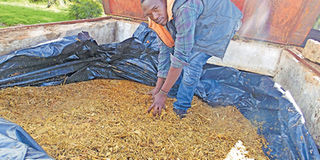Why we use inoculants, not molasses to make silage

An employee of Marimba Farm in Meru inspects silage whose preparation involved inoculants use. Over a year ago, the farm switched to using inoculants, ensuring that they have quality feeds, whose nutritional value does not degrade. PHOTO | CAROLINE WAMBUI | NMG
What you need to know:
- Amid the shortage, unscrupulous traders normally take advantage of farmers to sale low quality molasses.
- To overcome the challenges, among others, Marimba Farm, a government institution situated some 17km from Meru, has fully embraced silage inoculants.
- Over a year ago, the farm switched to using inoculants, ensuring that they have quality feeds, whose nutritional value does not degrade.
- Silage made using a quality inoculant maintains a stable aerobic stability at feed-out stage while that made using molasses heats up.
The past months have seen dairy farmers grapple with shortage of molasses, a situation that has affected the production of silage as the sweetener helps in fermentation of the feeds making them palatable.
Amid the shortage, unscrupulous traders normally take advantage of farmers to sale low quality molasses.
To overcome the challenges, among others, Marimba Farm, a government institution situated some 17km from Meru, has fully embraced silage inoculants.
Sitting on 180 acres, the farm hosts 50 animals of the Ayrshire, Jersey and Guernsey breeds, which they feed mainly on silage.
Over a year ago, the farm switched to using inoculants, ensuring that they have quality feeds, whose nutritional value does not degrade.
Edwin Mutegi, the officer in-charge of Marimba Farm, explains that once the fodder is chopped, one dilutes a gram of the inoculant with two litres of water and sprays on it. “Spraying is done as the silage is being packed and compacted.
The gram should be used on a tonne of fodder and the compaction should not exceed a depth of 30cm for effectiveness. The process is repeated until all the fodder is stored in the silo,” he says.
He notes silage made using a quality inoculant maintains a stable aerobic stability at feed-out stage while that made using molasses heats up.
“A quality inoculant prevents the growth of any non-desirable micro-organisms while silage made from molasses encourages the growth of micro-organisms.”
According to him, a good quality inoculant allows preservation of energy and prevents oxidation of sugars.
CAUSES HETING UP
Seth Oluoch, an animal nutritionist at Caroga Pharma, notes that challenges associated with using molasses have forced farmers to turn to silage inoculants.

Another employee in the farm feeds the dairy cattle that they keep. The farm hosts 50 animals of the Ayrshire, Jersey and Guernsey breeds, which they feed mainly on silage. PHOTO | CAROLINE WAMBUI | NMG
“With molasses, a farmer has to dilute the ingredient with water in a ratio of say 1:3 depending on the quality of fodder. Dilution of molasses with water means adding more dissolved oxygen in the silage and the greater the tonnage, the greater the quantities of water to be used.”
In the case a farmer ensiles a tonne of silage, he would dilute 10 litres of molasses with 30 litres.
He adds that molasses often causes heating up when the silage is enclosed making it hot, a factor which many farmers used in making an assumption that the silage is ready.
According to Oluoch, this is misleading as the process that was meant to be anaerobic has turned aerobic.
“This process of heating up is easily solved by the use of a homo-fermentative inoculant that makes the most efficient use of plant sugars in lowering the pH especially when the moisture content is marginally high.
Some inoculants are applied as dry powders while others are diluted with water and sprayed on the fodder, both of which are equally effective though.
Oluoch notes that the inoculants need to be kept cool and dry before use to keep the bacteria active.
“One key thing to note when using a liquid inoculant is to avoid diluting the product with chlorinated water as the chlorine can kill the lactic acid bacteria if it is too high. Again, once an inoculant has been diluted, and is ready for use, it needs to be used within 24 hours,” says Oluoch.





